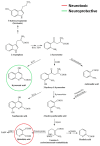Smouldering Lesion in MS: Microglia, Lymphocytes and Pathobiochemical Mechanisms
- PMID: 37628811
- PMCID: PMC10454160
- DOI: 10.3390/ijms241612631
Smouldering Lesion in MS: Microglia, Lymphocytes and Pathobiochemical Mechanisms
Abstract
Multiple sclerosis (MS) is an immune-mediated, chronic inflammatory, demyelinating, and neurodegenerative disease of the central nervous system (CNS). Immune cell infiltration can lead to permanent activation of macrophages and microglia in the parenchyma, resulting in demyelination and neurodegeneration. Thus, neurodegeneration that begins with acute lymphocytic inflammation may progress to chronic inflammation. This chronic inflammation is thought to underlie the development of so-called smouldering lesions. These lesions evolve from acute inflammatory lesions and are associated with continuous low-grade demyelination and neurodegeneration over many years. Their presence is associated with poor disease prognosis and promotes the transition to progressive MS, which may later manifest clinically as progressive MS when neurodegeneration exceeds the upper limit of functional compensation. In smouldering lesions, in the presence of only moderate inflammatory activity, a toxic environment is clearly identifiable and contributes to the progressive degeneration of neurons, axons, and oligodendrocytes and, thus, to clinical disease progression. In addition to the cells of the immune system, the development of oxidative stress in MS lesions, mitochondrial damage, and hypoxia caused by the resulting energy deficit and iron accumulation are thought to play a role in this process. In addition to classical immune mediators, this chronic toxic environment contains high concentrations of oxidants and iron ions, as well as the excitatory neurotransmitter glutamate. In this review, we will discuss how these pathobiochemical markers and mechanisms, alone or in combination, lead to neuronal, axonal, and glial cell death and ultimately to the process of neuroinflammation and neurodegeneration, and then discuss the concepts and conclusions that emerge from these findings. Understanding the role of these pathobiochemical markers would be important to gain a better insight into the relationship between the clinical classification and the pathomechanism of MS.
Keywords: glutamate excitotoxicity; lymphocyte; microglia; mitochondrial dysfunction; multiple sclerosis; neurodegeneration; neuroinflammation; oxidative stress; slowly expanding lesion; smouldering lesion.
Conflict of interest statement
The authors have no conflict of interest to declare.
Figures





References
-
- Biström M., Jons D., Engdahl E., Gustafsson R., Huang J., Brenner N., Butt J., Alonso-Magdalena L., Gunnarsson M., Vrethem M., et al. Epstein–Barr virus infection after adolescence and human herpesvirus 6A as risk factors for multiple sclerosis. Eur. J. Neurol. 2020;28:579–586. doi: 10.1111/ene.14597. - DOI - PMC - PubMed
Publication types
MeSH terms
Substances
Grants and funding
LinkOut - more resources
Full Text Sources
Medical

